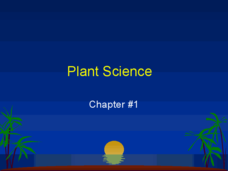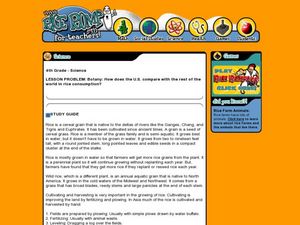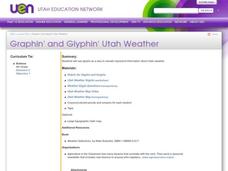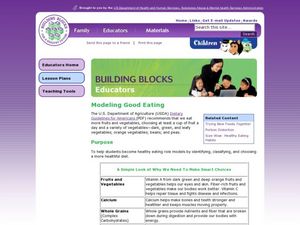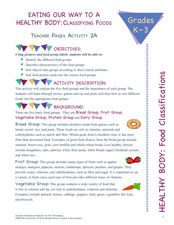Curated OER
Importance of Rice
Third graders explore the importance of rice in our world. In this rice farming lesson, 3rd graders discover how much rice we use on a daily basis. Students also discover myths from other cultures about rice. Students color code a map of...
Curated OER
Plant Science Chapter #1
It may not stand as a cohesive presentation, but individually you may find a use for these slides. One slide describes how civilization began once man learned to plant and harvest food. Another explores the population growth over time....
Curated OER
Honey Bunches of Oats
Students explore a variety of crops that are used in our food products utalizing a box of the cereal, Honey "Bunches of Oates." Percentages of each of the three different kinds of flakes present are calculated.
Curated OER
Food Groups
In this food groups worksheet, students choose two words from the word list that belong in each of 7 food group categories. The groups are: dairy, poultry, grains, proteins, vegetables, fruits and junk food.
Curated OER
How is Rice Harvested?
Second graders look at how rice is harvested. In this rice harvesting lesson plan, 2nd graders learn vocabulary associated with rice harvesting. They read or listen to a study guide before making Squishy Rice Balls from balloons and rice.
Curated OER
Rice Consumption
Fourth graders discover facts about rice and how it is farmed. In this rice research lesson, 4th graders investigate how much rice is eaten in the United States compared to other countries. Students research countries and graph the...
Curated OER
Kitchen Math - Levels I & II
Identify appropriate abbreviations, food-measurement terminology, techniques, equivalents, and calculate recipe-size adjustments and demonstrate proper measuring techniques. Identify abbreviations Compute equivalents Identify measuring...
Curated OER
Quick Breads, Biscuit Method Lab
Students watch the teacher demonstrate following the biscuit recipe. They follow the recipe themselves and prepare bread sticks and cinnamon rolls. While their breads are cooking, students work the provided crossword puzzle.
Curated OER
Contributions
Students taste rice, one of the Nations first people's contributions. In this contributions lesson plan, students discover what rice looks like, feels like and tastes like. Students make recipes using wild rice.
Curated OER
Junk Food Jungle
Students become familiar with the nutritional value of foods advertised on television and in magazines. They discuss different types of foods and where snack food fits into a healthy diet. They categorize the foods they eat as healthy or...
Curated OER
Kernel Count!
Here is an impressive and thorough lesson on estimation. Young mathematicians estimate how many kernels of popcorn can fit in a tablespoon, then how many tablespoons of kernels can fit in a baby food jar. The popcorn is then popped. All...
Curated OER
Early 18c Europe: Proto-Industrialism
Providing key information, visually appealing pictures, and thought-provoking questions, this series of slides presents your class with a study of 18th century Europe as it becomes increasingly urbanized. From peasants to princes, the...
Curated OER
Starch
Students examine the basics of starch and how it is used in food. In this photosynthesis instructional activity students experiment with variables that affect starch production in photosynthesis.
Curated OER
What Happens to Rice at the Mill
First graders investigate rice farming by creating an art project. In this agriculture lesson, 1st graders read about the path rice takes from a mill to your plate. Students utilize a piece of paper to create a...
Curated OER
Botany: What are the types of rice?
Students explore the different types of rice. In this botany instructional activity, students match characteristics of rice with its variety.
Curated OER
Economics
Fourth graders read a poem about rice and identify its importance around the world. In this rice lesson, 4th graders read about the role of rice in various nutritional sectors around the world. Students complete two word problems about...
Curated OER
How has rice been produced throughout history?
Fourth graders research rice history. In this rice history lesson, 4th graders discover the farming methods used to cultivate rice. They read about the role of rice in many cultures.
Curated OER
Graphin' and Glyphin' Utah Weather
Fourth graders use glyphs as a way to visually represent information about Utah weather. These nonverbal representations help students collect and interpret data in a visual format.
Curated OER
Hoops
With a creative premise involving a basketball competition, this game could be used to review basic science, grammar and math concepts in a fourth or fifth grade classroom. It is a fun idea, and a motivating way to review information....
Curated OER
Getting the Most From Your Food
Students study the food pyramid to learn about healthy food. In this healthy foods instructional activity, students create a chart of the healthy foods they eat in a day. Students discuss their choices and how they could make...
Curated OER
Modeling Good Eating
Students identify and classify the items in a healthy diet. In this dietary lesson, students listen to a song about healthy eating while listening for good snack foods. They use pictures of the snacks to complete a large chart by...
Curated OER
Economics: What Are Some Other Uses for Rice?
Sixth graders investigate ways rice is sold by creating a chart of the different rice foods. In this economics instructional activity, 6th graders examine their local food store and list at least 10 rice by-products in a class chart....
Curated OER
Eating Our Way to a Healthy Body: Classifying Foods
Students examine the major food groups. In this classifying foods lesson, students discover the 5 food groups as they read books and play games. Students then sort foods into the appropriate food groups
Curated OER
A Recipe for Reading: Asian Style Rice and Eggs
Learners read, write about, and cook with rice in this home economics lesson. They reflect on the experience eating rice at home or in other ethnic foods.



